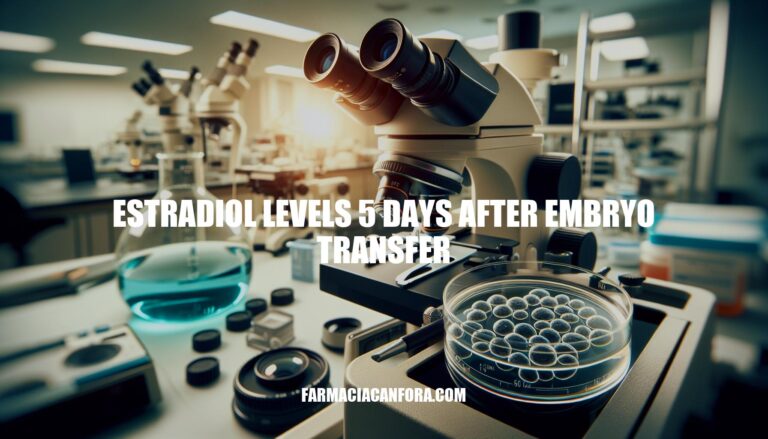Monitoring estradiol levels 5 days after progesterone-level-1-week-after-embryo-transfer”>embryo transfer in IVF treatments is crucial. Estradiol, a form of estrogen, helps maintain the uterine lining, which is essential for embryo implantation and early pregnancy support. Tracking these levels can provide insights into the likelihood of successful implantation and help identify any potential issues early on. This monitoring ensures that the hormonal environment remains optimal for the developing embryo, increasing the chances of a successful pregnancy.
Significance of Estradiol Levels
Estradiol levels 5 days after embryo transfer are crucial because they help assess the endometrial receptivity and overall hormonal environment necessary for embryo implantation and early pregnancy maintenance. Adequate estradiol levels indicate that the endometrium is properly primed to support the embryo, increasing the chances of a successful pregnancy.
Normal Estradiol Levels
Five days after embryo transfer, estradiol levels can vary widely. Typically, they range from approximately 50 pg/mL to 500 pg/mL.
- Low Range (~50 pg/mL): May indicate insufficient hormonal support or potential issues with implantation.
- Mid Range (~300 pg/mL): Generally considered a good sign, suggesting adequate hormonal support and a favorable environment for implantation.
- High Range (~500 pg/mL): Indicates strong hormonal support, which is usually positive but can sometimes suggest overstimulation.
These levels help assess the hormonal environment and the likelihood of successful implantation.
Factors Influencing Estradiol Levels
Here are some factors that can affect estradiol levels 5 days after embryo transfer:
-
Medication:
- Estradiol Supplements: Often given to support the endometrium, these can directly influence estradiol levels.
- Progesterone: Used to support the luteal phase, it can interact with estradiol levels.
- Gonadotropins: These stimulate the ovaries and can cause fluctuations in estradiol.
-
Individual Patient Differences:
- Ovarian Reserve: Women with a higher ovarian reserve may have higher baseline estradiol levels.
- Age: Estradiol levels can vary with age, often decreasing as women get older.
- Body Mass Index (BMI): Higher BMI can affect hormone levels, including estradiol.
- Underlying Health Conditions: Conditions like polycystic ovary syndrome (PCOS) or thyroid disorders can impact estradiol levels.
-
Embryo Quality and Implantation:
- The quality of the embryo and its successful implantation can also influence hormone levels, including estradiol.
-
Stress and Lifestyle Factors:
- Stress, diet, and overall lifestyle can have subtle effects on hormone levels.
These factors can interact in complex ways, making it important to monitor estradiol levels closely during this period. If you have any specific concerns or symptoms, it’s always best to consult with your healthcare provider.
Monitoring and Adjustments
Methods to monitor estradiol levels 5 days after embryo transfer:
- Blood Tests: Serum estradiol levels are measured through blood samples.
- Transvaginal Ultrasound: Used to assess endometrial thickness and correlate with estradiol levels.
Potential adjustments to treatment:
- Estradiol Supplementation: If levels are low, additional estradiol may be prescribed.
- Progesterone Adjustment: Progesterone doses might be modified based on estradiol levels to support the endometrium.
- Cycle Monitoring: Close monitoring and possible adjustments in medication dosages to optimize conditions for implantation and early pregnancy.
Clinical Implications
Clinical Implications of Abnormal Estradiol Levels 5 Days After Embryo Transfer:
-
Low Estradiol Levels:
- Implantation Failure: Low estradiol can indicate poor endometrial receptivity, potentially leading to implantation failure.
- Early Pregnancy Loss: Insufficient estradiol may be associated with early pregnancy loss.
-
High Estradiol Levels:
- Ovarian Hyperstimulation Syndrome (OHSS): Elevated estradiol levels can increase the risk of OHSS, especially in fresh cycles.
- Adverse Pregnancy Outcomes: High estradiol levels might impair endometrial receptivity, reducing clinical pregnancy rates.
Possible Next Steps in Treatment:
-
Monitoring and Adjustment:
- Frequent Monitoring: Regular blood tests to monitor estradiol levels and adjust medication dosages accordingly.
- Medication Adjustment: Modifying hormone supplementation to optimize estradiol levels.
-
Alternative Protocols:
- Freeze-All Strategy: In cases of high estradiol, consider freezing all embryos and transferring in a subsequent cycle.
- Natural Cycle Transfer: For low estradiol, a natural cycle transfer might be considered to improve endometrial receptivity.
-
Supportive Measures:
- Additional Hormonal Support: Providing additional hormonal support, such as progesterone, to enhance endometrial receptivity.
- Lifestyle Modifications: Advising on lifestyle changes that may positively influence hormone levels and overall reproductive health.
Monitoring Estradiol Levels Post-Embryo Transfer
Monitoring estradiol levels 5 days after embryo transfer is crucial for assessing endometrial receptivity and the likelihood of successful implantation.
Estradiol helps maintain the uterine lining, essential for embryo implantation and early pregnancy support. Adequate estradiol levels indicate a properly primed endometrium, increasing chances of a successful pregnancy.
Factors Affecting Estradiol Levels
Factors affecting estradiol levels include:
- Medication
- Individual patient differences
- Embryo quality
- Stress
- Lifestyle factors
Monitoring Methods
Monitoring methods include:
- Blood tests
- Transvaginal ultrasound
Abnormal Estradiol Levels and Treatment Adjustments
Abnormal estradiol levels can lead to implantation failure, early pregnancy loss, OHSS (Ovarian Hyperstimulation Syndrome), or adverse pregnancy outcomes.
Treatment adjustments may involve:
- Monitoring and adjustment of hormone supplementation
- Alternative protocols such as freeze-all strategy or natural cycle transfer
- Supportive measures like additional hormonal support or lifestyle modifications


